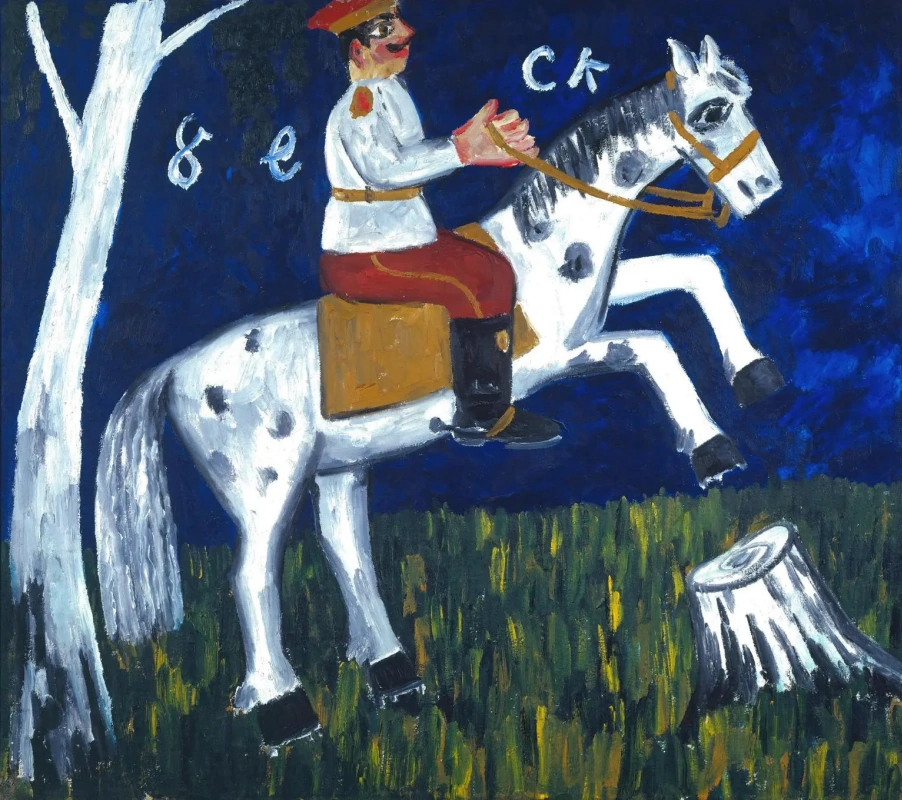log in
Enter site
Login to use Arthive functionality to the maximum
Soldier on horseback
Mikhail Larionov • Painting, 1911, 99.1×87 cm


















Description of the artwork «Soldier on horseback»
"Soldier on a horse" enters into the so-called "soldiers' series" Larionov ("Smoking soldier", "Morning in the barracks").
In the First World War, Larionov was mobilized, served in the rank of warrant officer, in East Prussia he ordered an injury, after which he recovered several months in a hospital. Soldiers life Larionov writes, not dividing what is happening on the "high and low" areas. "Resting Soldier" he even ironically compares it to the reclining Venus. Larionov's world is simple-minded, rude (the inscriptions on the fences and walls are clearly not quotes from Ecclesiastes), but at the same time it is infinitely kind and honest.
Reliance on national roots is one of the peculiarities of Russian neo-primitivism. If the French primitives sought inspiration in Africa and Polynesia, then Russian artists turned to folk art, popular prints, fair art. The second important feature: Russian neo-primitivism is by no means stylization. This is not a salon game "imagine that we are like them," it is a sincere expression of folk aesthetics. We find echoes of neo-primitivism in the works of Chagall ("Spoon of milk"), Burliuk ("Peasant Woman and Horse"), Malevich ("In the country")
The composition "soldier - horse" here seems like a toy: such toys were sold at fairs. On the primitivist paintings of Larionov, inscriptions are often encountered - these are echoes of the aesthetics of urban signs: printed and capital letters, signs, numbers. And here the half-tiger soldiers and the horse seem to be signed with the letters “c” and “k”, “e” miraculously repeats the figure of the horseman himself (Larionov often in the paintings of this period uses this principle of comparison), to the left - like a sign of a twisted horseshoe, perhaps symbolizing motive failed movement.
And indeed, the picture seems to be showing movement, but there is no movement here, the image seems to be stopped in space. And even without “as if” - let us pay attention to the fact that there is a big stump in front of the rearing horse, which clearly impedes movement. The figure of a soldier is tense, on his face - not a shadow of thought: it seems he does not know that something blocks the way. By the way, behind the tree you can see, somehow the rider on the horse traveled it. There is a great suspicion that merit is in that horse, which will have to deal with the stump itself.
The muzzle of a horse with an expression of meek humility is directed downwards. Unlike the soldier, the horse clearly follows the road. It seems it was like that. The soldier was ordered to “go”, he saddles his horse, and then the horse’s work to find a way ... At the same time, the artist’s soft ironic view carries no disdain. He sees the soldier’s world as it is and accepts it.
Author: Alain Esaulova
In the First World War, Larionov was mobilized, served in the rank of warrant officer, in East Prussia he ordered an injury, after which he recovered several months in a hospital. Soldiers life Larionov writes, not dividing what is happening on the "high and low" areas. "Resting Soldier" he even ironically compares it to the reclining Venus. Larionov's world is simple-minded, rude (the inscriptions on the fences and walls are clearly not quotes from Ecclesiastes), but at the same time it is infinitely kind and honest.
Reliance on national roots is one of the peculiarities of Russian neo-primitivism. If the French primitives sought inspiration in Africa and Polynesia, then Russian artists turned to folk art, popular prints, fair art. The second important feature: Russian neo-primitivism is by no means stylization. This is not a salon game "imagine that we are like them," it is a sincere expression of folk aesthetics. We find echoes of neo-primitivism in the works of Chagall ("Spoon of milk"), Burliuk ("Peasant Woman and Horse"), Malevich ("In the country")
The composition "soldier - horse" here seems like a toy: such toys were sold at fairs. On the primitivist paintings of Larionov, inscriptions are often encountered - these are echoes of the aesthetics of urban signs: printed and capital letters, signs, numbers. And here the half-tiger soldiers and the horse seem to be signed with the letters “c” and “k”, “e” miraculously repeats the figure of the horseman himself (Larionov often in the paintings of this period uses this principle of comparison), to the left - like a sign of a twisted horseshoe, perhaps symbolizing motive failed movement.
And indeed, the picture seems to be showing movement, but there is no movement here, the image seems to be stopped in space. And even without “as if” - let us pay attention to the fact that there is a big stump in front of the rearing horse, which clearly impedes movement. The figure of a soldier is tense, on his face - not a shadow of thought: it seems he does not know that something blocks the way. By the way, behind the tree you can see, somehow the rider on the horse traveled it. There is a great suspicion that merit is in that horse, which will have to deal with the stump itself.
The muzzle of a horse with an expression of meek humility is directed downwards. Unlike the soldier, the horse clearly follows the road. It seems it was like that. The soldier was ordered to “go”, he saddles his horse, and then the horse’s work to find a way ... At the same time, the artist’s soft ironic view carries no disdain. He sees the soldier’s world as it is and accepts it.
Author: Alain Esaulova


